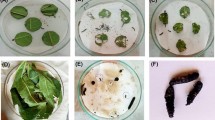Abstract
In leaf disc choice assays and topical application experiments, the neem (Azadirachta indica) limonoids azadirachtin, salannin, deacetylgedunin, gedunin, 17-hydroxyazadiradione and deacetylnimbin were found to be potent antifeedants and growth inhibitors to the cotton bollworm, Helicoverpa armigera (Hübner) (Lepidoptera: Noctuidae). Azadirachtin was most potent in both respects. Gross dietary utilisation (efficiency of conversion of ingested food) of H. armigera was also decreased following topical application as well as after treatment in the diet. Growth inhibition in topically treated H. armigera may be primarily attributed to decreased food intake. The antifeedant and growth-inhibitory effects of the neem limonoids are discussed.
Résumé
Au cours des essais sur rondelles de feuilles et des expériences d’application par voie de contact, les limonoïdes d’azadiractine dérivés du nîme (Azadirachta indica): la salannine, la deacétylegédunine, la gédunine, la 17-hydroxyazadiradione et la deacétylenimbine ont montré des pouvoirs anorexigène et inhibiteur de croissance chez le ver rose du cotonnier, Helicoverpa armigera (Hübner) (Lepidoptera: Noctuidae). L’azadiractine était puissante dans les deux variantes de traitement. L’utilisation brute de la diète, c’est-à-dire la capacité de transformer les aliments ingérés, a aussi diminué chez H. armigera lors de l’application par voie de contact de même qu’après l’incorporation du produit dans la diète. L’inhibition de la croissance lors de l’application par voie de contact peut être attribuée en premier lieu, à la baisse de la quantité ingérée d’aliments. Les effets anorexigènes et inhibiteurs des limonoïdes de nîme sont discutés.
Similar content being viewed by others
References
Butterworth J. H. and Morgan E. D. (1971) Investigation of the locust feeding inhibition of the seeds of neem tree, Azadirachta indica. J. Insect Physiol. 17, 969–977.
Champagne D. E., Isman M. B. and Towers G. H. N. (1989) Insecticidal activity of phytochemicals and extracts of the Meliaceae, pp. 95–109. In Insecticides of Plant Origin (Edited by J. T. Arnason, B. J. R. Philogene and P. Morand). ACS Symp. Ser. 387. American Chemical Society, New York.
Finney D. J. (1971) Probit Analysis. Cambridge University Press, 333 pp.
Hassanali A., Bentley M. D., Ole Sitayo E. N., Njoroge P. E. W. and Yatagai M. (1986) Studies on limonoid insect antifeedants. Insect Sci. Applic. 7, 495.
Ishida M., Serit M., Nakata K., Juneja L. R., Kim M. and Takahashi S. (1992) Several antifeedants fromneem oil, Azadirachta indica A. Juss., against Reticiditermes speratus Kolbe (Isoptera: Rhinotermitidae). Biosci. Biotech. Biochem. 56, 1835–1838.
Isman M. B., Koul O., Luczynski A. and Kaminski J. (1990) Insecticidal and antifeedant bioactivities of neem oil and their relationship to azadirachtin content. J. Agric. Food Chcni. 38, 1406–1411.
Jeyabalan D. (1994) Studies on the influence of host plant, pesticides and neem products in relation to feeding, growth and reproduction of Helicoverpa armigera (Hübner) (Insecta: Lepidoptera: Noctuidae). M.Phil. Thesis, Bharathiar University, Coimbatore, India, 175 pp.
Koul O. and Isman M. B. (1992) Toxicity of the limonoid allelochemical cedrelone to noctuid larvae. Entomol. exp. appl. 64, 281–287.
Koul O., Shankar J. S. and Kapil R. S. (1996) The effect of neem allelochemicals on nutritional physiology of larval Spodoptera litnra. Entomol. exp. appl. 79, 43–50.
Lee S. M., Klocke J. A., Barnby M. A., Yamasaki R. B. and Balandrin M. F. (1991) Insecticidal constituents of Azadirachta indica and Meliaazedarach (Meliaceae), pp. 293–304. In Naturally Occurring Pest Bioregulators (Edited by P. H. Hedin). American Chem. Soc., Washington, DC.
Liu S. V., Alford A. R., Rajab M. S. and Bentley M. D. (1990) Effect and modes of action of citrus limonoids against Leptinolarsa decemlineata. Physiol. Entomol. 15, 37–45.
Mordue (Luntz) A. J. and Blackwell A. (1993) Azadirachitin: An update. J. Insect Physiol. 39, 903–924.
Murugan K. and Jeyabalan D. (1995) Antifeedant and ovipositional effect of neem root extract (Azadirachta indica A Juss.). Neem Neivsl. 12, 45–46.
Murugan K., Senthil Kumar N., Babu R. and Senthil Nathan S. (1995) Antifeedant and ovipositional deterrent effects of Azadirachta indica A. Juss. Neem Newsl. 12, 43–44.
Rembold H. (1989) Azadirachtins—Their structure and mode of action, pp. 150–163. In Insecticides of Plant Origin (Edited by J. T. Arnason, B. J. R. Philogene and P. Morand). ACS Sym. 387, American Chemical Society, Washington.
Serit M., Ishida M., Hagiwara N., Kim M., Yamamota T. and Takahashi S. (1992) Meliaceae and Rutaceae limonoids as termite antifeedants evaluated using Reticiditermes speratus Kolbe (Isoptera: Rhinotermitidae). J. Chem. Ecol. 18, 593–603.
Simmonds M. S. J. and Blaney W. M. (1996) Azadirachtin: Advances in understanding its activity as an antifeedant. Entomol. Exp. appl. 80, 23–26.
Waldbauer G. P. (1968) Consumption and utilization of food by insects. Adv. Insect Physiol. 5, 228–229.
Author information
Authors and Affiliations
Corresponding author
Rights and permissions
About this article
Cite this article
Murugan, K., Jeyabalan, D., Kumar, N.S. et al. Antifeedant and Growth-Inhibitory Properties of Neem Limonoids against the Cotton Bollworm, Helicoverpa armigera (Hübner). Int J Trop Insect Sci 18, 157–162 (1998). https://doi.org/10.1017/S1742758400007803
Accepted:
Published:
Issue Date:
DOI: https://doi.org/10.1017/S1742758400007803
Key Words
- azadirachtin
- deacetylgedunin
- deacetylnimbin
- dietary utilisation
- feeding deterrents
- gedunin
- Helicoverpa armigera
- 17-hydroxyazadiradione
- salannin




